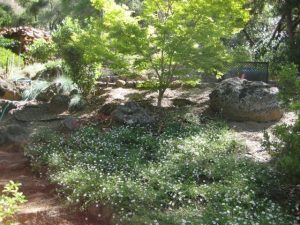If you live between the wilderness and a rural community, you have to expect some rural visitors. Yet, last summer, we were taken by surprise as one robust plant after another disappeared underground or shriveled overnight after the roots were completely severed. We had noticed an increase in dirt mounds throughout the meadow areas surrounding our neighborhood, and it did not take long before the pesky excavators moved into paradise… our garden!
Managing gopher populations is not an easy task. They spend most of their time underground, and are active year-round – both day and night. In addition to decimating healthy plants, gophers can damage drip lines, diverting water away from garden plants. Gophers become more active with warmer temperatures in spring, and with rain-soaked soils in late fall. They tend to have litters in the spring and in early winter. Controls should be targeted at these times to prevent reproduction and minimize garden destruction.
There are a number of management tools that people have used to control gopher populations; however, they vary in their effectiveness. Repellents, frightening devices and gas cartridge fumigation have no impact on decreasing gopher populations. Aluminum phosphide fumigation does work but can only be administered by a licensed fumigator. Using a barrier mesh buried 2 feet deep around your entire garden is impractical if your garden is already established, and it doesn’t stop the more persistent individuals from tunneling underneath. This method works well though at the base of raised beds.
Traps work well for small areas. The fundamental key to traps is accurate placement and a sensitive trigger. The first step in setting traps is to locate the main burrow by probing the ground about 8-12 inches from a plug in a fresh mound. Once you know where the burrow is, you can expose one of its main tunnels by removing the overlying dirt. Main tunnels are deeper and tend to have a diameter the size of a tennis ball, whereas surface tunnels are golf ball-sized. You may need to enlarge the tunnel once it is open before setting two traps facing in opposite directions. Tie the traps to a stake so they are not hauled away. It is not necessary to cover the tunnel once the traps are set but it is important to check the traps often and move them if they are empty after two days.
Baits are more economically feasible for large agricultural areas or massive infestations. There are two types of baits: those that are lethal with one dose, and anticoagulants, which require 5-10 days of feeding before reaching toxic levels. Research indicates ~50% control with the one dose lethal bait but ~70-80% control with anticoagulants. Anticoagulants are less toxic to pets and children if they were to find the bait. Strychnine (0.5%) mixed with grain kills with one dose. After adding strychnine to a main tunnel, cover it with a piece of plywood to prevent non-gopher animals from eating it and check it daily to be sure it is working. If there are no dead gophers, relocate the bait to an active tunnel. Anticoagulants are mixed with grain and embedded in wax to form blocks. Place a block in a main tunnel, cover it and then check it after 10 days.
Gophers are destructive to gardens, landscapes and agricultural lands. A gopher’s sense of smell is much greater than a dogs, so they will avoid things inserted into their tunnel system. They are resilient to the many management techniques used to reduce their numbers. To gain the upper hand, consider hiring a professional trapper who is observant, persistent, and will rid them from your area.
Kathi Joye is a University of California Cooperative Extension Master Gardener of Tuolumne County.


